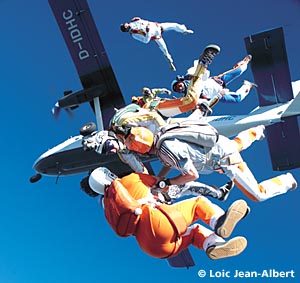 |

A formation by Patrick Passe's group on both sides. 
Milko's group.
The Cosmic Police
Mike Brooke's group.
Lack of control on landing is illegal, the man with the bright jacket keeps close surveillance so that the man with the white jacket needn't intervene. |
By Patrick Passe
In the bus converted into a manifest, Gilles Défourneaux was the boogie's great conductor. Assisted by Julie Peton, he managed the manifest and the calls for boarding. With their computer and their mike, they both contributed to the fluidity of the 9 150 jumps made during the week. Not far from the manifest, Hugo Zeler and Bastien Cruciani, invited the skydivers to go to the pre-boarding zone where plane tickets and equipments were checked.
The scenery of a true boogie was standing all around, coloured with wind blades. The tents of Boogie Man and Matter (free-fly suits manufacturers), of Icarus Canopies and Parachutes de France stood here and there. The BlueBook stand had a hazier atmosphere with its round reserve canopy as a tent. Further away, Philippe Mauduit offered his unique tee shirts. And in the middle, there stood a white portico serving as a frame for a giant tube that was painted everyday in freefall by one of the free-fly jumpmasters. Every morning, a new colour was applied on this first abstract work of art made in flight.
Higher, in the staff tower, Claude Daviet's look embraced the DZ, the countryside around it and the sky. No accident or incident happened during the boogie. In front of the tower, Joël Cruciani, with his bright orange jacket, paced up and down the landing zone. Lack of control was illegal. Near the runway, boardings took place one after another, thanks to Yan's two Super Otters, the Boogie Performance Casa and the Lapalisse Skyvan. Jumps were made at 4 200 metres.
The 350 registered skydivers could benefit from the load organising system. Most of them did. Variety was the key word for free-flying. The jumps were built around Babylon, with Stéphane Fardel and Fred Fugen, and around Gigliola, Tazio, Marco Tiezzi and Loïc Jean-Albert. Among the many jumps made, a vertical 16-way in the heart of a 44-way made from 2 planes flying in formation, a seven point head down 8-way, a line made of 8 atmonautes and a 12-way with vertical and belly flyers were the more remarkable. As for formation skydiving, the groups ranging from 16 to 20 people were organised by Milko, Mike Brooke and Patrick Passe. The three groups made jumps with 3 to 6 points, depending on the jump. People had as much fun in Dario Jotti's intermediate groups and in the groups organised by the members of the national junior team, Benjamin Reffet, Guillaume Bernier, Jérémie Rollett and Julien Degen. They also made jumps with beginners and joined for pleasure 20-way sequence jumps. Bruno Perin and Jean Debièvre, also from the junior team, gave a hand at the beginning and at the end of the boogie.
In the middle of the week, Milko's, Mike Brooke's and Patrick Passe's groups merged for a 62-way and the magical sight of the 2 Otters and the Skyvan flying in formation. The figure was completed on the fourth attempt. It was the biggest formation ever made in the Sky of Lapalisse. Stéphane Cruciani, assisted by Wendy Smith, edited each day's best images caught in free-fly or formation skydiving. A work of quality for this video, that was as usual awaited with impatience every night in front of the large screen.
This year, the Espace Boogie regained its character. After its last time
in Vichy in 2000 where it was slightly running out of steam, after a
first time in Lapalisse last year with a taste of ordinary, the August
boogie in the Allier county was noble again. Among its European
community, people were talking with regrets about Cruciani's great
boogies, as if this August had an air of the best meetings in Vichy.
| ||||||||||||||||||||||||||||
|
|
|||||||||||||||||||||||||||||

















